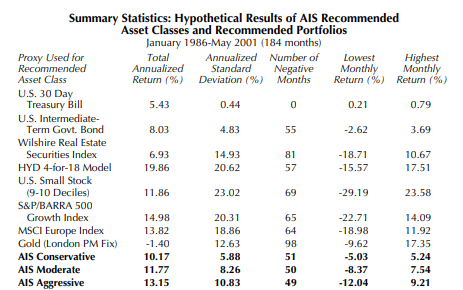We have received many inquiries recently regarding our Professional Asset Management (PAM) program. Callers frequently ask for our “total returns.” The entire premise of PAM, and of the INVESTMENT GUIDE is that each investor is unique with regard to their personal circumstances (i.e. age, children, financial goals, etc.) and tolerance for risk. It is therefore our aim to provide a range of portfolios suitable for a variety of circumstances. We are not a “one-size-fits-all” mutual fund. We have therefore struggled with providing a meaningful answer.
We can, however, look at past hypothetical portfolio returns under different assumptions. The table below presents outcomes for our recommended asset classes, as well as for our “conservative,” “moderate,” and “aggressive” portfolios. We gathered month-end data for indices that correspond to these recommended classes. We were constrained by our own 4-for-18 high-yield Dow plan; though we have mid-month data going back as far as 1963, we have month-end data beginning only in January 1986. We are continuing to gather month-end prices for earlier periods, and we will publish our findings as we update our database.
It is important to understand that these data present what our current allocations would have rendered had they been in place at the beginning of 1986, and remained fixed through out that period. Our recommended asset classes have been expanded considerably over the past 14 years, and our recommended allocations might have varied from time to time, as conditions changed.
Except for the high-yield Dow plan, the data presented below make no allowance for transaction costs, so commissions, fund expenses, and trading costs are not reflected. We assumed that the three portfolios were rebalanced if in any given quarter at least one asset class exceeded its target allocation by more than 1%. These historical data do not represent actual results and future results will almost certainly vary.

Also in This Issue:
The 2001 Tax Act: What It Means For You
New Benefits for College Savings Plans
The Hidden Tax: Cost of Tax Complexity
Charitable Remainder Plans: As Attractive As Ever
Newly Recommended Funds
The High-Yield Dow Investment Strategy
Recent Market Statistics
The Dow-Jones Industrials Ranked by Yield
To access the full article, please login or subscribe below.
Already a Subscriber?
Log in now
Subscribe Today
Get full access to the Investment Guide Monthly.
Print + Digital Subscription – $59/YearIncludes 12 Print and Digital Issues
Print + Digital Subscription – $108/2 Years
Includes 24 Print and Digital Issues
Digital Subscription – $49/Year
Includes 12 Issues
Digital Subscription – $98/2 Years
Includes 24 Issues

